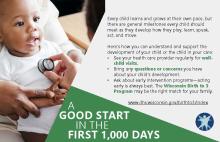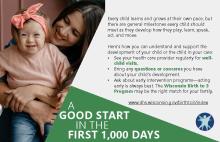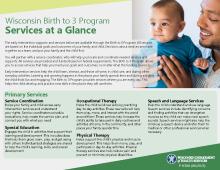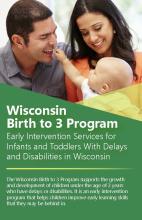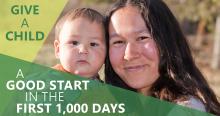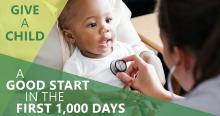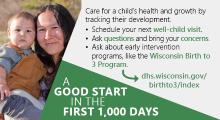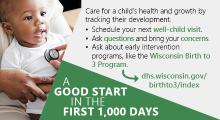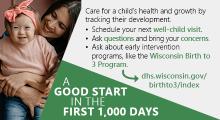Birth to 3 Program: First 1,000 Days Toolkit Materials for Families
Reach families with this media toolkit. Help them learn more about:
- Child development.
- Early signs of delays and disabilities.
- How the Birth to 3 Program can help.
Order resources
Request your free copies of the materials below. Fill out a Forms/Publications Order form, F-80025A. Email it to dhsfmorder@dhs.wisconsin.gov. Print orders are available in bundles of 50. Please allow two to four weeks to receive your order.
These resources are available to:
- Stock in your offices, including:
- County health buildings.
- Clinics.
- Child care facilities.
- Schools.
- Any places families and young children visit.
- Share on your website.
- Give to families you refer. Or those that want to know more about the program.
- Share with local partners who interact with your children and families.
Shareable materials
The Wisconsin Birth to 3 Program First 1,000 Days Brochure, P-02928, explains the basics of the Birth to 3 Program. It is available in English, Hmong, and Spanish.
There is a blank spot on the back of the brochure. You can use this space to place a sticker with the name of your organization and contact information.
The Wisconsin Birth to 3 Program First 1,000 Days Postcard, P-02929:
- Lets families know how important it is to act early when their child has signs of delays or disabilities.
- Reminds families to keep seeing their doctor regularly.
- Offers tools to help track development milestones.
You can send this postcard to families on your distribution list. It comes in three different styles. Each style is available in English, Hmong, and Spanish.
Birth to 3 Program Services at a Glance, P-03011, explains the supports and services available to families in the Birth to 3 Program. It is available in English, Hmong, and Spanish.
The Early Intervention Services for Infants and Toddlers With Delays and Disabilities in Wisconsin booklet, P-03022, helps families understand how the Birth to 3 Program works. It explains:
- Early intervention services
- The natural environment
- Team members
- It is available in English, Hmong, and Spanish.
The video fact sheet Birth to 3 Program: Why is Early Intervention Important? explains:
- Early intervention.
- Why early intervention is important.
- How the Wisconsin Birth to 3 Program can help.
The video fact sheet Birth to 3 Program: Why is a Natural Environment Important? defines natural environments for families. It explains why providing services in the natural environment is important.
Social media
Below is social media content. You can post it to your Facebook, Twitter, and Instagram pages. It will help people across Wisconsin learn more about the Birth to 3 Program. You can customize as indicated.
You can also follow DHS on social media and share these posts directly from our:
Visuals
Download these images to post on your social media channels. They are available in English and Spanish.
Image 1
Image 2
Example post text
Copy and paste the text to share on your social media feeds. The English versions are available on this page. Get the Spanish versions in the First 1,000 Days Translated Social Media and Newsletter Toolkit Content for Families (Word).
Post 1: We’re accepting appointments for well-child visits! These are a great time for parents and caregivers to ask questions about your child’s development and raise any concerns to your doctor. [add clinic website or contact info] #EarlyIntervention
Post 2: Did you know? Well-child visits aren’t just for immunizations – they’re also a time to talk to your doctor about your child’s growth and development. Schedule yours today: [add clinic website or contact info]
Post 1: As a parent or caregiver, you know your child best. You can make sure your child’s health and growth is on track using a few simple tools. Find them at www.dhs.wisconsin.gov/children/development.htm.
Post 2: If your child shows signs of delays or disabilities, #EarlyIntervention can help! The #DHSWI Birth to 3 Program connects eligible families with services and supports to help your child learn and grow. www.dhs.wisconsin.gov/birthto3.
Post 3: Well-child visits are more important than ever. Make sure to schedule your child’s next visit with your health care provider to stay up to date on immunizations, developmental milestones, and overall health.
Post 4: When learning your child has a delay or disability, knowing next steps is important to support their development. We can provide information to help you decide which programs and resources are right for you. [add organization’s website OR www.dhs.wisconsin.gov/children/resources.htm]
Post 5: #EarlyIntervention—because parents and caregivers are their children’s first and best teachers. If your child has a delay or disability, contact your county to ask about Wisconsin’s early intervention program: www.dhs.wisconsin.gov/birthto3/contacts.htm
Post 6: #FosterParents and #AdoptiveParents often care for infants who have experienced stress or other trauma. Help them learn and grow by tracking milestones and going to well-child visits. Learn how: www.dhs.wisconsin.gov/children/development.htm
Newsletter and web content
Consider helping DHS support local Child Find efforts. Share messaging about early detection of delays and disabilities, basics about the Birth to 3 Program, and early intervention.
Articles
Copy and paste text from pre-made articles to help develop a story in your next bulletin, newsletter, email, or website update for families. The English versions are available on this page. Get the Spanish and Hmong versions in the First 1,000 Days Translated Social Media and Newsletter Toolkit Content for Families (Word).
Article to remind families about the importance of well-child visits
As a parent or caregiver, one of the best steps you can take to support child development is to make sure the child in your care sees their health care provider regularly for well-child visits.
What are well-child visits?
Well-child visits are a chance to talk with your health care provider about the growth and development of the child. These regularly scheduled visits are a time to:
- Talk with the child’s health care provider about how to keep them healthy.
- Ask questions and address any concerns about the child’s growth and learning.
- Make sure all services, such as immunizations, are up to date.
How can I understand the child’s development?
Every child learns and grows at their own pace, but there are general milestones every child should meet as they develop how they play, learn, speak, act, and move. You can track these milestones using the Centers for Disease Control and Prevention toolkit, or download the free app.
Remember, delays can happen for many reasons, and it is best to recognize and address them as early as possible. If you have any concerns, even something small, make sure to tell your health care provider.
How can early intervention help?
For some children, early intervention can be a helpful way for them to build skills and reach developmental milestones.
The Wisconsin Department of Health Services’ Birth to 3 Program serves families with children under the age of 3 who have delays or disabilities. Unlike other programs or individual services, the Birth to 3 Program partners you with a team that will support your skills as a parent or caregiver, and help your child learn, interact, and thrive at home, in child care, and during other everyday activities like going to the library, store, or park.
Ask your health care provider about the Birth to 3 Program, or contact your local county Birth to 3 Program for more information. Learn more about other children’s services programs available through the Department of Health Services on the Services for Children with Delays or Disabilities webpage.
Article to introduce families to the Birth to 3 Program
Every child learns and grows at their own pace. How a child plays, learns, speaks, acts, and moves can show if they are reaching important developmental milestones. If you or your health and child care professionals notice the child is behind in their development, early intervention can help.
The Wisconsin Department of Health Services’ Birth to 3 Program serves families with children under the age of 3 who have delays or disabilities. A team of professional service providers partners with families in the program to support growth and learning. Family culture, beliefs, and individualized outcomes help shape what and how services are provided. For more information about the program, refer to the Birth to 3 Program First 1,000 Days brochure.
Partner with a team to support child development
When a child is found eligible for the Birth to 3 Program, your family is supported by a full team that helps the child learn, interact, and thrive at home, in child care, and during other everyday activities like going to the library, store, or park. The program team may include:
- A service coordinator
- Early childhood special education teacher
- Speech, occupational, and/or physical therapist
- Other professionals or service providers as necessary
One of these professional service providers will be the person who visits your home most often. They are called the “primary coach.”
Understand how the Birth to 3 Program can support you
The Birth to 3 Program supports you as the child’s first and best teacher. You will learn about:
- Communicating the child’s needs.
- Helping the child learn and grow.
- Knowing and exercising your rights in the program.
- Maintaining a healthy, early, and strong relationship with the child.
The primary coach can also answer questions about challenges you experience, give insight on activities, help you decide if technology or assistive aids might be a good fit, and more.
Contact your local county
If you think the Birth to 3 Program might be right for your family, or if your health care provider has recommended it, you can contact your county program for more information. They are there to answer your questions and help explore this option.
Article that explains Birth to 3 Program Services
Every child learns and grows at their own pace, but there are general milestones every child should meet as they develop how they play, learn, speak, act, and move. One of the most important things you can do to care for a child’s health and growth is to track their developmental milestones and act early if you notice signs of a delay or disability.
What can you do if an infant or toddler shows signs of a delay or disability? Don’t wait and see—schedule a well-child visit and ask about early intervention.
What is early intervention?
Early intervention is the term used to describe the services and supports that are available to infants and toddlers with developmental delays and disabilities and their families. It is a special education program that supports a child’s development through support from a variety of trained and qualified staff.
The Birth to 3 Program is Wisconsin’s early intervention special education program.
The Birth to 3 Program supports children with any types of delays, disabilities, or conditions. Your family partners with a team of professional service providers who can help with your specific needs. The team includes a:
- Service coordinator.
- Early childhood special education teacher.
- Speech, occupational, and/or physical therapist.
- Other professionals or service providers as necessary.
One of these professional service providers is the primary coach. The primary coach will be your main contact and use their expertise to help you and the child in learning and developing as the child grows. The primary coach will help you access other professionals on your team as needed to support your individualized plan.
What services are provided?
All services are based on the individual goals and desired outcomes of your family and child. You might receive special education and instruction; medical and health services’ physical, occupational, and speech therapy; hearing and vision services; assistive technology; service coordination; or other services that help you better understand the child and improve their development.
Examples of services include:
- A speech and language pathologist helps you learn ways for your child to communicate their wants and needs when words are difficult to understand, or they become frustrated when you do not know what they want. The pathologist might show you ways to expand your child’s diet when they have difficulty eating certain foods, or it is a challenge to sit down for a meal together.
- An occupational therapist helps you position the child in their car seat so they can enjoy a car ride and visit a family friend. They show you how to use songs to engage the child in the car and give you tips to practice throughout the week that make going to the grocery store a little easier for both you and the child.
- A physical therapist helps the child use a gait trainer so they can go on a walk with you and other members of the family. They might help you prepare them for the walk, show you how to get them out the door and onto the sidewalk, and suggest strategies for keeping an eye on your other child who is riding a bike.
Where does early intervention happen?
Learning and growing happens in the places your family spends the most time. Your home, a child care location, and other places you spend time in regularly are part of your family and child’s natural environment. Birth to 3 Program services are provided in natural environments so the child will develop new skills in the places they will use them.
Website ads
Download the web ads to display on your website for families. Make the image a clickable link to the Birth to 3 Program webpage.
Image 1
Image 2



